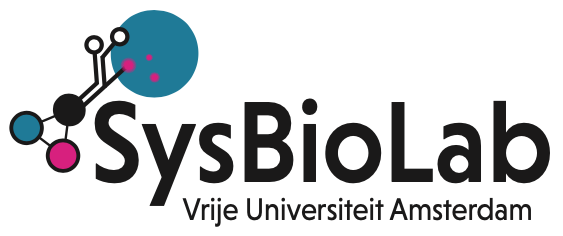Modeling and Microbial Communities
We publish internships via the Biosb-interns mailing list server. If you subscribe to this mailing server you will obtain emails with internship projects in the fields of Bioinformatics and Systems Biology. You can also browse the archive of earlier mails.
You can also contact the team leader Douwe Molenaar directly with questions about opportunities for internships: d.molenaar@vu.nl
For additional internships, see the table below or contact Matti Gralka.
| Project title | Type of research | Supervisor(s) |
|---|---|---|
| How do alternative stable states in ecological communities arise? | Theory/computational (Master) | Matti Gralka (m.gralka[at]vu.nl) |
| Background The concept of alternative stable states has long been a dominant framework for studying the influence of historical contingency in the assembly of ecological community. This project will focus on alternative stable states in communities of microbes, which are not only very important for humans and the environment, but also provide ideal model systems to explicitly test mathematical theories of community assembly in experiments. Common example of alternative stable states exhibited by complex microbial systems are i) clear-water states and turbid, algae- or cyanobacteria-dominated states in freshwater lakes, ii) healthy and dysbiotic gut microbiomes in apparently similar patients, and iii) rumen microbiomes in cows, sheep, or goats with high or low production of methane (an important greenhouse gas). Recent experiments in microbial microcosms have clearly shown that alternative stable states can stochastically emerge from a common starting point. Similarly, novel theory has shown the boundaries of a single stable community state in some models. However, we still don’t know what determines the number of alternative stable states, what facilitates transitions between them, and which mathematical models are appropriate to model these processes. A better understanding of alternative stable states and how to manipulate them may improve our ability to steer microbiomes into a healthier or more productive state. Your project In this project, you will use two established mathematical models of microbial communities as a starting point to understand alternative stable states. These models make fundamentally different assumptions: one class assumes direct pairwise or higher-order interactions between species (generalized Lotka-Volterra models), the other class models interactions explicitly through the exchange of chemicals, such as the uptake of glucose or the excretion of acetate or antibiotics (consumer-resource models). You will compare these models regarding their ability to produce alternative stable states and their predictions for the number of alternative stable states. As we start to understand these models better, we will tune and extend them to discover principles governing alternative stable states in these models, such as to what degree (and what kind of) nonlinearities are required to produce alternative stable states. A prior familiarity with programming languages (e.g., R, Python, Mathematica) and differential equations is highly recommended. Methods and techniques: development of mathematical models, numerical solution of differential equations, analytical approaches (as appropriate). In addition to regular meetings with your supervisor, you will participate and present in our Systems biology group meeting and journal club. Number of positions available 1 Duration of project: 5-10 months Start date anytime |
||
| The role of multi-copy genes in central metabolism | Theory/computational (Master) | Matti Gralka (m.gralka[at]vu.nl) |
| Background Many bacterial genomes harbor multiple copies of genes from the same family (orthologs) that are predicted to have the same function. Gene copies in a given genome can be quite divergent and more closely related to orthologs in distantly related species than to the other copies in the same genome. By comparing with phenotypic data, we have recently found that having multiple copies of genes in certain central metabolic pathways is correlated with preferential and efficient use of that pathway, suggesting that having multiple copies of the same genes can make species more competitive in the ecological niche where that pathway is active. Why do bacteria harbor these multiple copies of the same gene, and how did they obtain them? How are they organized on the chromosome? Do the resulting enzymes serve different purposes? Is each enzyme better adapted to certain environmental conditions? Are the different copies expressed at the same time, or are their relative expression levels regulated? Your project In this project, you will address these questions in two parts. Firstly, you will analyze and compare large numbers of genomes, visualizing the positions of genes copies on different genomes to attempt to find patterns in their organization. You will compare the sequences of the copies between organisms for different gene families and derive statistical insight into the evolution of these gene copy numbers. This will be performed on a smaller set of 200 genomes from marine bacteria, for which phenotypic data is available, as well as a large (50,000) set of genomes, for which you will develop automated data analysis pipelines. Secondly, you will reanalyze existing transcriptomics and proteomics data of different model species, e.g., E. coli or B. subtilis, and analyze the expression patterns of genes present in multiple copies across different conditions. This will give you insight into the functional role of these gene copies, whether they are always coexpressed or more tightly regulated. Ultimately, this will allow you to speculate on the role of gene copy numbers in the evolution of metabolic pathways in bacteria. A prior familiarity with basic bioinformatics tools and a programming language is required for this project. In addition to regular meetings with your supervisor, you will participate and present in our Systems biology group meeting and Journal club. Number of positions available 1 Duration of project: 5-10 months Start date anytime |
||

Recent Comments